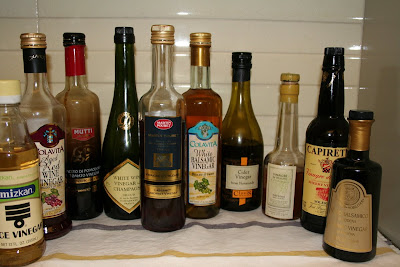Inspired by One-Knife Woman's comment to my post "The World's Greatest Chef's Knives?", I am writing this post a bit ahead of schedule. I apologize for the length of this post, but there is a fair amount of ground to cover.I am not a knife expert, but did take a course in knife work, and learned a lot, from the famed Norman Weinstein. See my post "Knife Skills." Norman has a lot of thoughts about knives, some of which I outline below. (He has written a whole book, Mastering Knife Skills: The Essential Guide to the Most Important Tools in Your Kitchen, which I have not (yet) bought, so there is obviously a lot to learn about this topic.)
First, one must understand the difference between sharpening and honing. Sharpening, which involves removing part of the steel of the knife's blade, is done rarely, while honing, which realigns the microscopic teeth on a non-serrated blade, should be done pretty much each time you use the knife, with a sharpening steel. Norman suggests getting your good knives sharpened once a year by a professional. He recommends Henry Westphal Co., Inc., located at 11 West 25th Street, which does the sharpening off-site in a couple of days, and Broadway Panhandler. I used Henry Westpfal and found them to be very good. The guys who come around on the street (or are in front of Zabar's) may or may not be good. Norman is not a fan of electric sharpeners, including the Chef's Choice (which I used until I met him).

As far as what kind of knife to use, in our class we used forged Wusthof Classic knives: (i) a 10-inch chef's knife, (ii) a 8-inch chef's knife, (iii) a 6-inch "sandwich" knife, (iv) a 10-inch serrated knife (for carving, bread, tomatoes, etc.) and (v) a 3 1/2-inch paring knife. We did not use boning knives; that is for a different course. The point of using both the 8-inch and the 10-inch chef's knives was to let us conclude, as we all did, that the 10-inch is better in all respects; the extra heft actually makes cutting easier. The 6-inch sandwich is a great utility knife. There are other, more expensive Wusthof lines but the difference is with the handle, not the blade, so you choose. Wusthof (like Henckels) uses a high carbon stainless, which stays clean but is soft enough to hone with a sharpening steel. Speaking of steels, make sure you get one that is 2 inches longer than your longest knife, i.e., a 12-inch steel if you have a 10-inch chef's knife. You want to hone with a 20 degree angle (eyeball just 1/2 of 90 degrees and then a little less than 1/2 of that); Norman recommends holding the steel vertically, point on a towel on the counter, so you can make sure the angle is good, and I endorse this approach.
Norman does not like the hugely popular Santoku style of knife, primarily because it does not have a bolster and finger guard and also because he does not favor Japanese style knives. The latter is because they have thinner blades made of harder steel, which are sharper to start with but harder to keep sharp and honed. (Do not use ceramic knives; they are (and stay) wonderfully sharp but are expensive and very very easy to chip.)
That being said, I recently took a cooking lesson in Paris at Atelier Guy Martin and the chef was raving about the Shun knives, which he described as the Rolls-Royce of knives (and which they happen to sell at the Atelier). They use excellent Wusthof or Henckels knives in class.
To summarize, get a Wusthof 10-inch chef's knife and, if you have the money, a 6-inch "sandwich," together with a 12-inch sharpening steel. Use the steel frequently, and get professional sharpening once a year. A good bread and paring knife are great, too. If you have a santoku or Japanese knife and are happy with it, enjoy.
You can get Wusthof knives at discount prices at Broadway Panhandler and Henry Westpfal and through various on-line sources. If you prefer to pay list price, there's always Williams-Sonoma.
Other tips and pointers? What about comments on Shun knives or santokus?
Bobby Jay
 There is a wine and spirits shop in the eighth arrondissment that is worth a visit if you are interested in either: Augé, which has been in business since 1850. In addition to wines from all over France (primarily), Augé has a comprehensive selection of spirits, including their proprietary versions of famous single malt scotches. They work with leading distillers and, among other things, require them to use no dyes so the scotches look paler even though they retain the characteristics one would expect from the normal offerings by the same distillers. A wide selection of armagnacs, cognacs, calvadoses, etc. are also offered.
There is a wine and spirits shop in the eighth arrondissment that is worth a visit if you are interested in either: Augé, which has been in business since 1850. In addition to wines from all over France (primarily), Augé has a comprehensive selection of spirits, including their proprietary versions of famous single malt scotches. They work with leading distillers and, among other things, require them to use no dyes so the scotches look paler even though they retain the characteristics one would expect from the normal offerings by the same distillers. A wide selection of armagnacs, cognacs, calvadoses, etc. are also offered.



















